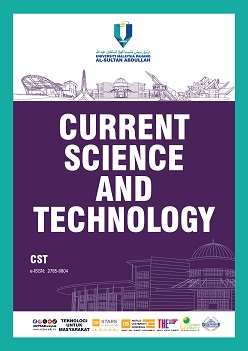The Effect of Diesel/Biodiesel Blend Ratio on Physical-Chemical Properties of Biodiesel
DOI:
https://doi.org/10.15282/cst.v3i2.10710Keywords:
Diesel, Biodiesel, Blends, Acid Value, Saponification valueAbstract
Biodiesel is a highly sustainable alternative to alleviate fossil fuel shortages and environmental concerns. Many countries have adopted the practice of blending biodiesel into diesel at specific ratios. This study focused on the effect of different biodiesel-diesel blend ratio in terms of acid value, saponification value, peroxide value, and iodine value, and analysed by using Ultraviolet-Visible (UV-Vis) spectroscopy. A series of diesel-biodiesel blends of B20, B40, B60, and B80 were prepared by mixing the biodiesel produced by refined, bleached, and deodorized palm oil through transesterification reaction with pure diesel. Based on the result, the FTIR spectrum showed a slight change in intensity and wavenumber for some possible functional groups but retained the same main characteristic peaks such as C=O, C-O, and OCH3. Predominant compound in biodiesel is oleic acid. Furthermore, acid value, saponification value, iodine value, and peroxide value increased from Euro 5 (B7) to B80 with linear regression (R2) of 0.9817, 0.9971, 0.7521, and 0.9911, respectively. The absence of aromatic compounds in biodiesel causes a decrease in the absorbance of UV light from Euro 5 to B80. Yet, tested parameters were positively accepted according to ASTM - D6751 standard method. Hence, determining the physicochemical properties of blend ratio is vital for industries to counter false claims economically and effectively.
References
[1] D. Neupane, “Biofuels from renewable sources, a potential option for biodiesel production,” Bioengineering, vol. 10, no. 1, p. 29, 2022.
[2] Neupane, D., Bhattarai, D., Ahmed, Z., Das, B., Pandey, S., Solomon, J. K. Q., Qin, R., & Adhikari, P. (2021). Growing jatropha (jatropha curcas L.) as a potential second-generation biodiesel feedstock. Inventions, 6(4), 60, 2021.
[3] S. Bertrand, Fact Sheet | Climate, environmental, and health impacts of fossil fuels, Environmental and Energy Study Institute, https://www.eesi.org/papers/view/fact-sheet-climate-environmental-and-health-impacts-of-fossil-fuels-2021. Accessed on 7 April 2023.
[4] L. Moffitt, Biodiesel group sees higher Malaysian blending by 2025, Argus Media, https://www.argusmedia.com/en/news/2428021-biodiesel-group-sees-higher-malaysian-blending-by-2025. Accessed on 12 December 2023.
[5] Zulqarnain, M. H. M. Yusoff, M. Ayoub, N. Jusoh and A. Z. Abdullah, “The challenges of a biodiesel implementation program in Malaysia,” Processes, vol. 8, no. 10, p. 1244, 2020.
[6] S. N. M. Khazaai, P. Bhuyar, M. H. A. Rahim, M. H. F. M. Alwi, S. Yiting and G. P. Maniam, “Rapid determination of diesel/biodiesel blend ratio using refractive index, density, and kinematic viscosity measurements,” Biomass Conversion and Biorefnery, pp. 1-7, 2021.
[7] R. N. Vilas Bôas and M. F. Mendes, “A review of biodiesel production from non-edible raw materials using the transesterification process with a focus on influence of feedstock composition and free fatty acids,” Journal of the Chilean Chemical Society, vol. 67, no. 1, pp. 5433– 5444, 2022.
[8] M. Anwar, M. G. Rasul, N. Ashwath and M. M. Rahman “Optimization of second-generation biodiesel production from Australian native stone fruit oil using response surface method,” Energies, vol. 11, no. 10, p. 2566, 2018.
[9] F. Ishola, D. Adelekan, A. Mamudu, T. Abodunrin, A. Aworinde, O. Olatunji et al., “Biodiesel production from palm olein: A sustainable bioresource for Nigeria,” Heliyon, vol. 6, no. 4, p. e03725, 2020.
[10] R. N. R. Sianipar, D. Ariyani and I. F. Nata, “Conversion of palm oil sludge to biodiesel using alum and KOH as catalysts,” Sustainable Environment Research, vol. 27, no. 6, pp. 291–295, 2017.
[11] D. Hamacher and W. Schräder, “Investigating molecular transformation processes of biodiesel components during long‐term storage via high‐resolution mass spectrometry,” Chemistry, Sustainability, Energy and Material, vol. 15, no. 14, 2022.
[12] M. A. Hazrat, M. G. Rasul, M. M. K. Khan, M. Mofijur, S. F. Ahmed, H. C. Ong et al., “Techniques to improve the stability of biodiesel: A review,” Environmental Chemistry Letters, vol. 19, no. 3, pp. 2209–2236, 2021.
[13] V. Thangarasu and R. Anand, “Comparative evaluation of corrosion behavior of Aegle Marmelos Correa diesel, biodiesel, and their blends on aluminum and mild steel metals,” In Advanced biofuels, pp. 443-471, Woodhead Publishing, 2019.
[14] V. Thangarasu and R. Anand, “Physicochemical fuel properties and tribological behavior of aegle marmelos correa biodiesel,” In Advances in eco-fuels for a sustainable environment, pp. 309–336, Woodhead Publishing, 2019.
[15] I. Simbi, U. O. Aigbe, O. O. Oyekola and O. A. Osibote “Chemical and quality performance of biodiesel and petrol blends,” Energy Conversion and Management: X, vol. 15, p. 100256, 2022.
[16] I. Sadiktsis, J. H. Koegler, T. Benham, C. Bergvall and R. Westerholm, “Particulate associated polycyclic aromatic hydrocarbon exhaust emissions from a portable power generator fueled with three different fuels – A comparison between petroleum diesel and two biodiesels,” Fuel, vol. 115, pp. 573–580, 2014.
[17] S. M. M. Hasnain, R. Chatterjee and R. P. Sharma, “Spectroscopic performance and emission analysis of glycine max biodiesel,” Journal of the Institution of Engineers (India): Series C, vol. 101, no. 3, pp. 587–594, 2020.
Downloads
Published
Issue
Section
License
Copyright (c) 2023 The Author(s)

This work is licensed under a Creative Commons Attribution-NonCommercial 4.0 International License.



